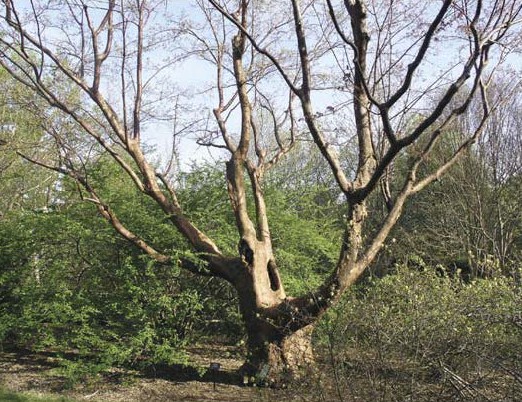The living collections of the Arnold Arboretum hold many important trees, but few are as significant as two of its paperbark maples (Acer griseum) which are celebrating their hundredth anniversary this year. Not only are these trees exquisitely beautiful, but they are also the oldest specimens of this rare Chinese species growing in North America. One of them is the well-known, low-branched individual growing on Bussey Hill along Chinese Path (see inside back cover), while the other is much taller and grows at the edge of the maple collection near the Bradley Garden of Rosaceous Plants (see front cover). Given their status as the original introduction of this highly ornamental species into North America, it is worth telling the story of how these two landmark trees came to be growing at the Arboretum.

In the fall of 1907, Ernest Henry Wilson collected at least two seedlings of paperbark maple in Hubei Province, China. In his field notebook for this trip, under the number 719, Wilson entered the following notation: “Acer griseum. tree 25–50 ft. margin of woods 4500–6000 ft. North Plants.” Ten years later, in 1917, Wilson rewrote this cryptic entry in Volume III of Plantae Wilsonianae, edited by C. S. Sargent. The following entry appears on page 427: “Acer griseum: Western Hupeh: north of Ichang, margin of woods, alt. 1500–2000 m., 1907 (No. 719; trees 8–16 m. tall; plants only).” According to our card files, two of the Acer griseum seedlings that Wilson collected under number 719 in Fang Xian, in Hubei Province, were accessioned in December 1907. They were originally assigned accession number 5813- 2, which was later changed to 12488, the number under which both trees are still listed today.
Citation: Del Tredici, P. 2007. The paperbark maple—One hundred years later. Arnoldia, 65(2): 40–41.
Among botanists, the maple family is notorious for having complex flowers, and Acer griseum is no exception. Technically the species is considered to be “androdioecious,” which means that some individuals produce only staminate (male) flowers while others produce perfect flowers with both male and female parts. Individual “A”, near the Bradley Garden, is a male specimen that produces no seed and stands some 64 feet tall (19.5 meters), with a spread of 44 feet (13.5 meters), and a diameter at breast height of 28 inches (70 centimeters) at the age of 100. Individual “B” has a more unusual form, having lost its leader some time ago. It stands only about 30 feet tall (9 meters), with a spread of 38 feet (11.5 meters), and a diameter of 37.5 inches (95 centimeters) at two feet off the ground. It produces perfect flowers and regularly produces viable seed which germinate spontaneously under the tree. This specimen was undoubtedly the source of the first generation of paperbark maples planted in North America. Indeed, the Arboretum’s distribution records indicate that seedlings of Acer griseum were first distributed in 1927, some twenty years after its introduction from China. All together some 79 seedlings, 4 seed lots, 3 packets of scions, and 1 packet of softwood cuttings of Acer griseum were distributed to various plant collectors and nurserymen between 1927 and 1945, firmly establishing the species in North American gardens.
Peter Del Tredici is Senior Research Scientist at the Arnold Arboretum and a Lecturer in the Department of Landscape Architecture at the Harvard Graduate School of Design.